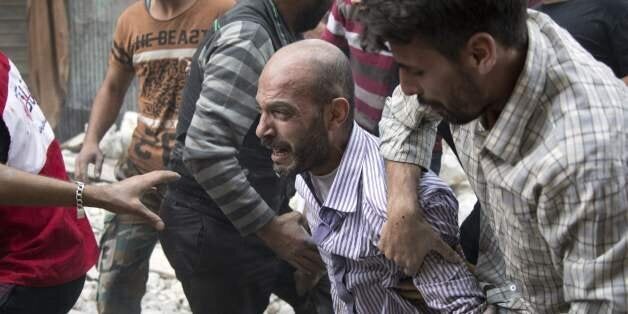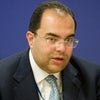
After a period of slow decline in conflict and violence since the end of the Cold War, conflicts have increased rapidly after 2010. Today, a reported 65 million people, including 21 million refugees, are displaced because of violence and conflict.
The increased frequency and intensity of violence is a serious challenge to achieving progress in our work to end extreme poverty. The world came together in 2015 to agree on a transformational agenda to address the needs of the poor and vulnerable - the 17 Sustainable Development Goals. But those goals may be out of reach unless we address the needs of refugees who are among the most vulnerable people in our world.
About 2 billion people live in countries where development outcomes are affected by fragility, conflict, and violence. Projections by the World Bank and OECD and others estimate that by 2030, between 50 percent and 64 percent of the global poor will live in countries affected by fragility, conflicts, and high levels of violence.
Gender-based violence has also been exacerbated by these conflicts and is increasingly being used as a weapon of war from Central Africa to the Middle East. This has deep impacts in society, leaving emotional scars, and impeding reconciliation and peace.
We must intervene to end conflicts and deal with the consequences of violence, but that is not enough to create a peaceful society. Once conflicts have become violent and civil war or major political violence has taken root, it is very difficult to return to a situation of sustained peace. Ninety percent of civil wars during the last decade occurred in countries that already had a civil war in the last 30 years.
Instead, our societies need to become better at preventing violence -- and it can be done.
The UN system has made enormous efforts to scale up its involvement in peacebuilding over the last decade, and has just undergone a comprehensive review of its peacebuilding architecture. The main findings of the review have been presented in a report titled "The Challenge of Sustaining Peace." Among its conclusions, the report finds that militarized responses address symptoms rather than root causes, and are therefore insufficient in responding to complex violent conflicts that may have new conflict drivers layered atop other longstanding conflict drivers. The report urges that we prioritize sustaining peace, something that is central to the UN Charter, recognizing that this will require a concerted effort from the entire UN system.
The World Bank Group has also increased its focus on fragility, conflict, and violence over the last decade. The World Bank Group's 2011 World Development Report on conflict, security, and development was a milestone for understanding peacebuilding from a development perspective. It has influenced the World Bank Group and many other donors, especially on crisis recovery and reconstruction -- and on supporting transitions to peace.
IDA, the World Bank Group's fund for the poorest, has considerably increased its level of financing for countries affected by situations of conflict and fragility. For example, from 2011-2013, IDA supported the expansion of health, nutrition and sanitation services in Kenya's Dadaab and Ethiopia's Dollo Ado refugee camps. The project benefited 1.5 million people, over 290,000 children received Vitamin A supplements, and over 85,000 children were treated for severe acute malnutrition. IDA is currently providing $200 million in concessional financing to help the governments of Lebanon and Jordan respond to the Syrian refugee crisis.
But these and other current efforts are insufficient. The international community needs to come together around an unprecedented effort to prevent the recurrence of violent conflicts. This is the only way we will be able to address the terrible human, social, and economic costs of conflicts to our societies. Development actors must work hand-in-hand with those working on facilitating political settlement and peace agreements. We also need to improve the effectiveness of the security sectors and humanitarian actors. This nexus is central for long-lasting peace.
This will require a number of coordinated actions, at both the local and global levels, including:
•Collectively address deep-seated grievances. These grievances stem from high levels of inequality, lack of inclusion of various groups, the abandonment of peripheral regions, unfair access to land and water, the competition for scarce natural resources, corruption, and poor governance. These complex and often long-standing issues are at the heart of modern conflict.
•Work together to improve institutions. Such transformations take a long time, requiring a change in attitudes from citizens, and strong engagement of communities. Institutions are not built effectively from the top -- they need to be built from the bottom-up. Capacity building is not effective if legitimacy and political commitment is not built first.
•Give full attention to gender issues. This includes the way men and women perceive their roles, and how these roles have evolved over time. There is strong evidence that stronger participation of women in the economy and society are factors that create resilience against violence.
•Shift the way both governments and international organizations approach violence and fragility. Supporting growth and poverty reduction needs to be done differently in societies that have weak cohesion, or which are more fragmented and fragile than in more homogeneous societies without a history of violence. In societies that have a stronger risk of violence, inclusion and managing perception of unfairness is central -- dealing with past trauma, and ensuring that old wounds are not reopened. This needs to be a central focus for policy makers.
•Help cities generate revenue to help support refugees and reduce tensions. Peter Sutherland, United Nations Special Representative of the Secretary-General for International Migration and Development, recently wrote that "The problem is that, despite devolution of power to local governments - a developed-country trend that is spreading to the developing world - many cities still operate with limited resources and authority to act." Putting resources closest to the people who need the revenues can reduce waste and accelerate and improve service delivery, which can help prevent the onset or recurrence of violence.
•Work with new actors playing a meaningful role. This includes civil society, the private sector, international economic institutions such as ECOWAS or others. We also need to analyze risks much more carefully, and understand that the earlier we intervene the easier it will be to prevent conflict, before grievances take root and societies start to fracture.
To better understand the way forward, the United Nations and the World Bank Group have jointly initiated a study to examine the evidence base on how development policies and programs contribute to the prevention of violent conflict. The study will look at what we have learned over the last 5 years regarding conflict, and will try to provide concrete recommendation on how to make development more effective at preventing violent conflicts.
Efforts like these -- to share knowledge and build closer collaboration between different humanitarian and development actors -- can improve our performance in preventing and responding to conflict, so that we can help build a world that is more peaceful, prosperous, and secure.
